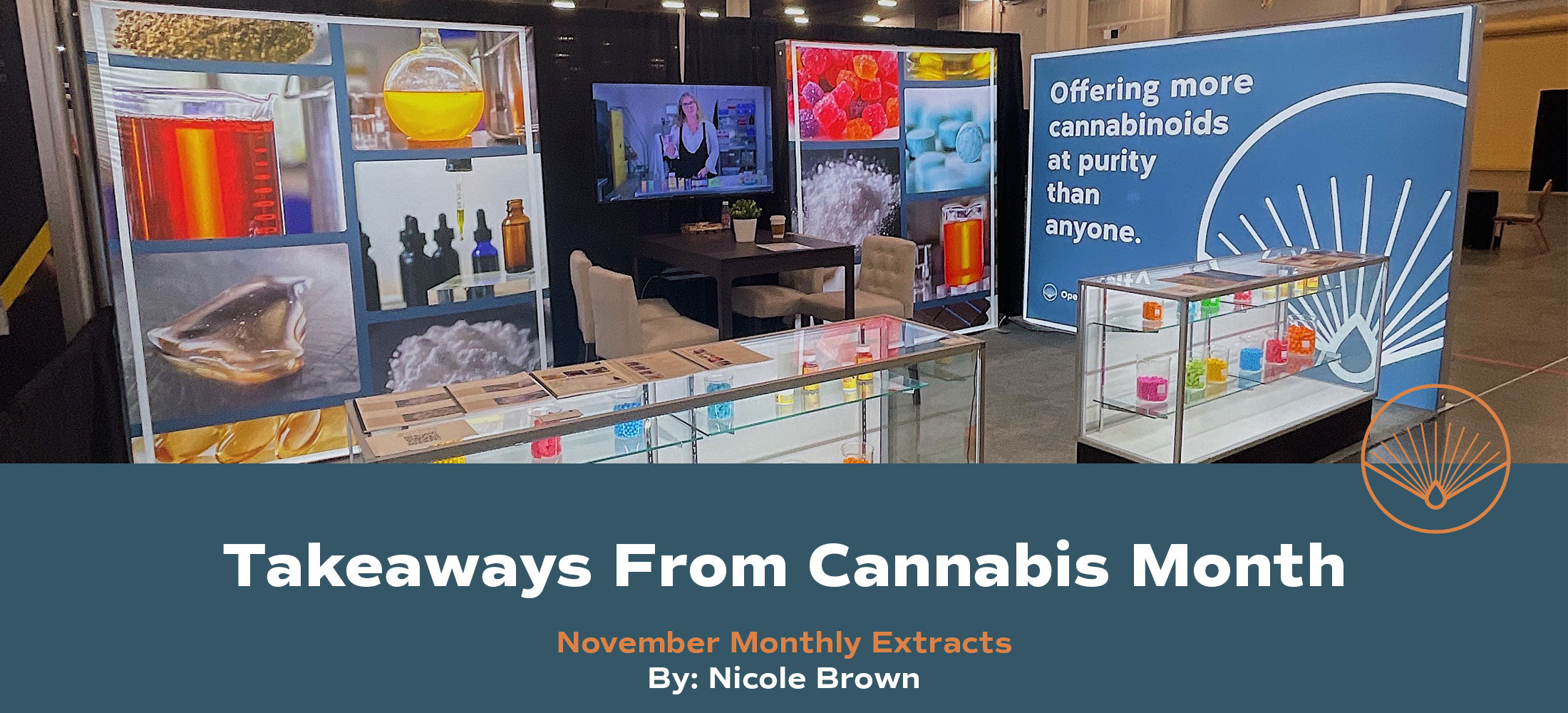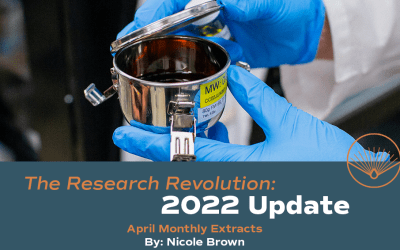Author: Nicole Brown
November 3, 2021 – 10 min read
It’s official — October is Cannabis Month. With keystone events including MJ Biz Con, MJ Unpacked, and Supply Side West, October provided the opportunity to take a close look at trends and predictions for the current state and future of the industry, and the learnings reveal a complex yet promising picture.
MJ BIZ CON
In a sign that the world is kind of returning to normal, MJBizCon 2021 opened its doors back for the largest B2B cannabis industry event. This is the time of year when tens of thousands of industry professionals descend on Las Vegas to show off their products and services, network, attend educational seminars, shake hands (or perhaps bump fists this year), and forge meaningful connections and partnerships.

MJBizCon, CEO and Founding Editor Chris Walsh, delivered his annual “State of the Industry and Predictions for 2022” presentation to kick off the festivities. Walsh, who has been covering the industry for several years, painted an optimistic picture of a growing and thriving industry that is becoming accepted by mainstream America.
Walsh offered six predictions for 2022, with two most pertinent to our industry. First, he feels at least four more states will legalize medical or adult use cannabis including one “sleeper.” He also predicted there won’t be a change in federal legalization next year, even on just banking regulations, but the stage will be set for future progress. Once cannabis becomes federally legal and dispensaries can start taking credit cards, look out.
Cannabis is on track to be a $50 billion industry
Despite the pandemic and sluggish economy, cannabis continues to exceed sales expectations. Experts predict the industry will make $26.4 billion this year, and Walsh and other industry analysts predict that number will double by 2025 to $45.9 billion. For some perspective, that lofty figure would exceed both the annual revenues of Craft beer and the Global opioid market.
California, the world’s largest cannabis market, saw 15 percent growth last year. Walsh points out that Arizona, Illinois, Massachusetts, Oklahoma, Nevada, and Pennsylvania will soon join “the billion-dollar club.”
Other cannabinoids are gaining steam
While THC and CBD grab all the headlines, other cannabinoid compounds in the plant are being embraced by the industry, including CBC, CBG, THCV, and CBN. More controversial compounds include Delta-8 and HHC, which are not banned in many states despite having psychoactive properties.
As more people become familiar with the healing properties of these other compounds, they realize that cannabis is not a two-trick pony. This represents an opportunity for entrepreneurs to expand the plant’s reach and appeal.
For example, Walsh pointed out that the edibles market share of products with CBN is up 14.3 percent in California.
State legalization is full-steam ahead
While the federal government continues to lumber slowly towards national legalization, state legalization is in full swing. Marijuana is legal for adults in 18 states and Washington, D.C. Medical marijuana is legal in 37. More states have legalized since early November of 2020 than the previous three-plus years combined. Here’s a snapshot.
2020:
- Montana (recreational)
- Vermont (recreational)
- Arizona (recreational)
- New Jersey (recreational)
- South Dakota (medical and recreational)
- Mississippi (medical)
2021
- Alabama (medical)
- Connecticut (recreational)
- New York (recreational)
- New Mexico (recreational)
- Virginia (recreational)
Walsh predicts that at least four states will legalize medical or recreational marijuana in 2022, including one “sleeper.” We have our eyes on you, Texas.
Investments are up
Like the rest of the economy, the pandemic slowed down investment in the cannabis industry. But some high-profile mergers and acquisitions this year have proved that investors are happily opening their wallets back up to cannabis companies.
Some recent examples include capital raises for Dutchie ($350 million), TrueLieve ($350 million), and GTI ($217 million).
M&As on the rise
As the economy returns to normal, so does the mergers and acquisitions activity. Just as before the pandemic, there has been increased consolidation in the cannabis industry as companies continue to be strategic about acquiring or investing in businesses.
Some notable M&A activity includes Truelieve and Harvest for $2.1 Billion and Jazz Pharmaceuticals and G.W. Pharma for $7.2 Billion.
MSO’s have also broadened their reach. Curaleaf operates in 23 states; Green Thumb Industries and Verana in 14, and Truelieve in 11.
Mo money, mo problems
But not everything is peachy for cannabis (despite the moniker of Justin Beiber’s new cannabis brand). Walsh highlighted several disturbing trends that continue to plague the industry.
- In California, for example, the illicit market continues to thrive and cut into the profits of a highly regulated legal market.
- Prohibitively high taxes and the 280e tax code, which forbids businesses from deducting any expenses from their gross income when it involves “trafficking” schedule I and II controlled substances (read: cannabis), have handicapped the industry and made the cost of doing business prohibitively expensive.
- Moreover, the great promise of social equity has largely been a disappointment. Well-intentioned programs throughout the country are beset with issues. According to Leafly’s Jobs Report 2021, African Americans represent roughly 13 percent of the U.S. population, but only 1.2% to 1.7% of business owners in the industry.
- Equally disturbing is that the percentage of minority executives in cannabis is actually decreasing. Walsh pointed out that in 2019, minorities made up 28 percent of the executive in cannabis. In 2021, minorities will make up 13.1 percent of executives. That’s .1 percent higher than the national average of 13 percent. So much for cannabis’s righting the wrongs of the War on Drugs.
Predictions for 2022
Overall, Walsh is mostly optimistic about the future. “Despite the lockdowns and the political, social, and economic unrest, the cannabis industry has prevailed – and been deemed essential,” he says.
MJ UNPACKED
MJ Unpacked is an exclusive event limited to brand and retail executives and accredited investors and represents a re-imagining of what a cannabis conference can look like. Hosted at Mandalay Bay, MJ Unpacked featured a brand exhibit hall, a main stage for speakers and panel discussions, a “money stage” for brands to pitch to investors, and private meeting rooms for investors. Though attendance was high, the setting and executive-only crowd gave the event a more elite, focused vibe than we’ve come to expect from trade shows.
The day kicked off with a discussion between industry legend Steve DeAngelo (the founder of one of the first legal dispensaries in the US and most recently of Last Prisoner Project), moderator George Jage, and Javan Bunch, who has been working in mainstream CPG for decades with companies such as Macy’s, Tory Burch, and Coach. “How Independent Retailers Can Compete in a Land of Giants” delivered a largely positive message. The three got deep into an insightful conversation about the power of authenticity and the advantage that long-time operators have when it comes to making informed decisions about product development and building relationships with consumers.

Left: Michael Spremulli, Right: Steve DeAngelo and Javan Bunch
“We’re here now, and we’ve been here for a while. We have an understanding of the product, the consumer, and the culture that surrounds it,” said DeAngelo, who went on to define what makes the cannabis industry unique.
“I think it’s really important to think about the consumer trajectory with cannabis. Because our product changes the way people feel, the way people think, and changes their values over time,” he said, noting that regular cannabis consumers tend to end up with a set of common values, which he defines as an appreciation for creativity, a skepticism toward central authority, and a love of nature.
Other highlights included an afternoon panel moderated by Casey Houlihan, executive director of the Oregon Cannabis Retailers Association (ORCA). “Increase Your Customer Base: Success Strategies for Acquiring & Developing Loyal Patrons” featured a roster of brand and retail rockstars: Seun Adedeji, CEO of Elev8, Sally Vander Veer, co-owner and CEO of Medicine Man, Andreas “Dre” Neumann, chief creative director at Jushi, and Suzan “Semii” Gebreyonas, brand manager of Monogram, Roc Nation Partnership, and The Parent Company.
The speakers emphasized how the cannabis industry is more collaborative than most mainstream industries with, as Casey Houlihan put it, “A synergistic approach rather than an adversarial approach.” Seun Adedji’s supported Houlihan’s take by talking about the help he’s received over the years from big brands and how he’s paying it back. “That’s how we’ve been able to win consistently—just treat people like gold,” he said.
SUPPLY SIDE WEST
Now in its 24th year, SupplySide West and Food Ingredients North America is the premier gathering of health & nutrition professionals bringing together buyers and suppliers from throughout the industry. SupplySide events are all about the science and strategy around the development of finished products driving the global business economy, with more than 700 leading providers and suppliers of ingredients, packaging, lab services, manufacturing and more.
This year, Open Book Extracts opened the event with a Breakfast Briefing for key stakeholders, “How Research, Regulations, & Innovation Will Drive and Disrupt the CBD Industry.” In this briefing, OBX shined a spotlight on why now is the time for large brands, nutraceutical and ingredient companies to chart their entrance into this $27B market opportunity.
In the briefing, OBX reviewed the current regulatory landscape for the cannabinoid market, along with the breakthrough safety, efficacy, and enhancement research that will support intelligent product development and regulatory clarity. We further shared the cutting edge ingredient technology that exists in the industry, namely the potential of minor cannabinoids, and the most important considerations in cannabinoid-enabled product innovation – a heightened focus on need-state driven formulations and elegant form factors that match customer rituals & lifestyles. (The presentation from the Breakfast Briefing can be accessed here.)
During the meetings and connections that continued throughout the event, it is evident that the wild ride provided by the legalization of hemp in 2018 took a screeching halt as COVID-19 hit and consumers fled en masse to immune-support supplements. But as the pandemic wore on, consumers came back to CBD. In and among the hiccups, smaller brands left the market, and even the largest brands took a hit if they were not prepared for the channel shift from bricks-and-mortar to online.
Meanwhile, savvy brands have pivoted away from straight-up CBD to respond to other consumer demands. In particular, several key trends emerged:
- CBD brands and new market entrants are more focused than ever on how they can meet safety, quality and efficacy standards for foods and beverage
- Complementary ingredients to supercharge a CBD-forward product and dominate condition-specific categories are becoming increasingly prevalent
- Minor cannabinoids, including CBN, CBC, THCV, and CBDV, are being sought after as hero ingredients to deliver on product differentiation and need-state formulations
When it comes to the minor cannabinoids, more than 100 other cannabinoids (beyond THC and CBD) have been identified. It seems evident that federal lawmakers intended to exclude intoxicating cannabinoids when they drafted the 2018 Farm Bill – and that intention is something the courts will consider if they are asked to interpret these laws. Excitingly, any of the other cannabinoids that don’t offer an intoxicating high could ultimately generate a legal market in the US.
Many of these minor cannabinoids have already started generating interest with existing CBD brands as well as large CPG companies looking to enter the market, with a focus on non intoxicating cannabinoids that hold high potential to be commercialized…
Food and dietary supplements containing CBD only may not be approved by the FDA as a result of the drug-exclusion rule, which prevents the inclusion of active ingredients in approved drugs or drugs being tested in clinical trials from being added to food or dietary supplements. Since CBD is an active ingredient in an approved drug, Epidiolex, CBD falls under the drug-exclusion rule. Equally, products containing THC will also fail to receive FDA approval since it’s considered a controlled substance under federal law.
But there is space for FDA approval for cannabinoids that aren’t THC or CBD to be included in dietary supplements, food, or beverages, including minor cannabinoids such as CBG, CBN, CBC, THCV, and CBDV. Such substances aren’t permitted to be included in food or dietary supplements until they have gone through the relevant FDA processes for a required food additive petition – namely, attaining an evaluated GRAS (generally recognized as safe) for food products or “new dietary ingredient” notification for dietary supplements.
The cannabinoid industry is already worth billions and looks set to grow into the future. While the regulatory and market picture remains complex, the optimism exuded from investors, retailers, cultivators, researchers and manufacturers to explore potential new hemp-derived products is at an all-time high. We expect to see a continued push and exploration of minor cannabinoids through the end of the year and into 2022, which hold promise as the foundation for the future of the cannabinoid-enabled market.
Author: Nicole Brown
November 3, 2021 – 10 min read
It’s official — October is Cannabis Month. With keystone events including MJ Biz Con, MJ Unpacked, and Supply Side West, October provided the opportunity to take a close look at trends and predictions for the current state and future of the industry, and the learnings reveal a complex yet promising picture.
MJ BIZ CON
In a sign that the world is kind of returning to normal, MJBizCon 2021 opened its doors back for the largest B2B cannabis industry event. This is the time of year when tens of thousands of industry professionals descend on Las Vegas to show off their products and services, network, attend educational seminars, shake hands (or perhaps bump fists this year), and forge meaningful connections and partnerships.

MJBizCon, CEO and Founding Editor Chris Walsh, delivered his annual “State of the Industry and Predictions for 2022” presentation to kick off the festivities. Walsh, who has been covering the industry for several years, painted an optimistic picture of a growing and thriving industry that is becoming accepted by mainstream America.
Walsh offered six predictions for 2022, with two most pertinent to our industry. First, he feels at least four more states will legalize medical or adult use cannabis including one “sleeper.” He also predicted there won’t be a change in federal legalization next year, even on just banking regulations, but the stage will be set for future progress. Once cannabis becomes federally legal and dispensaries can start taking credit cards, look out.
Cannabis is on track to be a $50 billion industry
Despite the pandemic and sluggish economy, cannabis continues to exceed sales expectations. Experts predict the industry will make $26.4 billion this year, and Walsh and other industry analysts predict that number will double by 2025 to $45.9 billion. For some perspective, that lofty figure would exceed both the annual revenues of Craft beer and the Global opioid market.
California, the world’s largest cannabis market, saw 15 percent growth last year. Walsh points out that Arizona, Illinois, Massachusetts, Oklahoma, Nevada, and Pennsylvania will soon join “the billion-dollar club.”
Other cannabinoids are gaining steam
While THC and CBD grab all the headlines, other cannabinoid compounds in the plant are being embraced by the industry, including CBC, CBG, THCV, and CBN. More controversial compounds include Delta-8 and HHC, which are not banned in many states despite having psychoactive properties.
As more people become familiar with the healing properties of these other compounds, they realize that cannabis is not a two-trick pony. This represents an opportunity for entrepreneurs to expand the plant’s reach and appeal.
For example, Walsh pointed out that the edibles market share of products with CBN is up 14.3 percent in California.
State legalization is full-steam ahead
While the federal government continues to lumber slowly towards national legalization, state legalization is in full swing. Marijuana is legal for adults in 18 states and Washington, D.C. Medical marijuana is legal in 37. More states have legalized since early November of 2020 than the previous three-plus years combined. Here’s a snapshot.
2020:
- Montana (recreational)
- Vermont (recreational)
- Arizona (recreational)
- New Jersey (recreational)
- South Dakota (medical and recreational)
- Mississippi (medical)
2021
- Alabama (medical)
- Connecticut (recreational)
- New York (recreational)
- New Mexico (recreational)
- Virginia (recreational)
Walsh predicts that at least four states will legalize medical or recreational marijuana in 2022, including one “sleeper.” We have our eyes on you, Texas.
Investments are up
Like the rest of the economy, the pandemic slowed down investment in the cannabis industry. But some high-profile mergers and acquisitions this year have proved that investors are happily opening their wallets back up to cannabis companies.
Some recent examples include capital raises for Dutchie ($350 million), TrueLieve ($350 million), and GTI ($217 million).
M&As on the rise
As the economy returns to normal, so does the mergers and acquisitions activity. Just as before the pandemic, there has been increased consolidation in the cannabis industry as companies continue to be strategic about acquiring or investing in businesses.
Some notable M&A activity includes Truelieve and Harvest for $2.1 Billion and Jazz Pharmaceuticals and G.W. Pharma for $7.2 Billion.
MSO’s have also broadened their reach. Curaleaf operates in 23 states; Green Thumb Industries and Verana in 14, and Truelieve in 11.
Mo money, mo problems
But not everything is peachy for cannabis (despite the moniker of Justin Beiber’s new cannabis brand). Walsh highlighted several disturbing trends that continue to plague the industry.
- In California, for example, the illicit market continues to thrive and cut into the profits of a highly regulated legal market.
- Prohibitively high taxes and the 280e tax code, which forbids businesses from deducting any expenses from their gross income when it involves “trafficking” schedule I and II controlled substances (read: cannabis), have handicapped the industry and made the cost of doing business prohibitively expensive.
- Moreover, the great promise of social equity has largely been a disappointment. Well-intentioned programs throughout the country are beset with issues. According to Leafly’s Jobs Report 2021, African Americans represent roughly 13 percent of the U.S. population, but only 1.2% to 1.7% of business owners in the industry.
- Equally disturbing is that the percentage of minority executives in cannabis is actually decreasing. Walsh pointed out that in 2019, minorities made up 28 percent of the executive in cannabis. In 2021, minorities will make up 13.1 percent of executives. That’s .1 percent higher than the national average of 13 percent. So much for cannabis’s righting the wrongs of the War on Drugs.
Predictions for 2022
Overall, Walsh is mostly optimistic about the future. “Despite the lockdowns and the political, social, and economic unrest, the cannabis industry has prevailed – and been deemed essential,” he says.
MJ UNPACKED
MJ Unpacked is an exclusive event limited to brand and retail executives and accredited investors and represents a re-imagining of what a cannabis conference can look like. Hosted at Mandalay Bay, MJ Unpacked featured a brand exhibit hall, a main stage for speakers and panel discussions, a “money stage” for brands to pitch to investors, and private meeting rooms for investors. Though attendance was high, the setting and executive-only crowd gave the event a more elite, focused vibe than we’ve come to expect from trade shows.
The day kicked off with a discussion between industry legend Steve DeAngelo (the founder of one of the first legal dispensaries in the US and most recently of Last Prisoner Project), moderator George Jage, and Javan Bunch, who has been working in mainstream CPG for decades with companies such as Macy’s, Tory Burch, and Coach. “How Independent Retailers Can Compete in a Land of Giants” delivered a largely positive message. The three got deep into an insightful conversation about the power of authenticity and the advantage that long-time operators have when it comes to making informed decisions about product development and building relationships with consumers.

Left: Michael Spremulli, Right: Steve DeAngelo and Javan Bunch
“We’re here now, and we’ve been here for a while. We have an understanding of the product, the consumer, and the culture that surrounds it,” said DeAngelo, who went on to define what makes the cannabis industry unique.
“I think it’s really important to think about the consumer trajectory with cannabis. Because our product changes the way people feel, the way people think, and changes their values over time,” he said, noting that regular cannabis consumers tend to end up with a set of common values, which he defines as an appreciation for creativity, a skepticism toward central authority, and a love of nature.
Other highlights included an afternoon panel moderated by Casey Houlihan, executive director of the Oregon Cannabis Retailers Association (ORCA). “Increase Your Customer Base: Success Strategies for Acquiring & Developing Loyal Patrons” featured a roster of brand and retail rockstars: Seun Adedeji, CEO of Elev8, Sally Vander Veer, co-owner and CEO of Medicine Man, Andreas “Dre” Neumann, chief creative director at Jushi, and Suzan “Semii” Gebreyonas, brand manager of Monogram, Roc Nation Partnership, and The Parent Company.
The speakers emphasized how the cannabis industry is more collaborative than most mainstream industries with, as Casey Houlihan put it, “A synergistic approach rather than an adversarial approach.” Seun Adedji’s supported Houlihan’s take by talking about the help he’s received over the years from big brands and how he’s paying it back. “That’s how we’ve been able to win consistently—just treat people like gold,” he said.
SUPPLY SIDE WEST
Now in its 24th year, SupplySide West and Food Ingredients North America is the premier gathering of health & nutrition professionals bringing together buyers and suppliers from throughout the industry. SupplySide events are all about the science and strategy around the development of finished products driving the global business economy, with more than 700 leading providers and suppliers of ingredients, packaging, lab services, manufacturing and more.
This year, Open Book Extracts opened the event with a Breakfast Briefing for key stakeholders, “How Research, Regulations, & Innovation Will Drive and Disrupt the CBD Industry.” In this briefing, OBX shined a spotlight on why now is the time for large brands, nutraceutical and ingredient companies to chart their entrance into this $27B market opportunity.
In the briefing, OBX reviewed the current regulatory landscape for the cannabinoid market, along with the breakthrough safety, efficacy, and enhancement research that will support intelligent product development and regulatory clarity. We further shared the cutting edge ingredient technology that exists in the industry, namely the potential of minor cannabinoids, and the most important considerations in cannabinoid-enabled product innovation – a heightened focus on need-state driven formulations and elegant form factors that match customer rituals & lifestyles. (The presentation from the Breakfast Briefing can be accessed here.)
During the meetings and connections that continued throughout the event, it is evident that the wild ride provided by the legalization of hemp in 2018 took a screeching halt as COVID-19 hit and consumers fled en masse to immune-support supplements. But as the pandemic wore on, consumers came back to CBD. In and among the hiccups, smaller brands left the market, and even the largest brands took a hit if they were not prepared for the channel shift from bricks-and-mortar to online.
Meanwhile, savvy brands have pivoted away from straight-up CBD to respond to other consumer demands. In particular, several key trends emerged:
- CBD brands and new market entrants are more focused than ever on how they can meet safety, quality and efficacy standards for foods and beverage
- Complementary ingredients to supercharge a CBD-forward product and dominate condition-specific categories are becoming increasingly prevalent
- Minor cannabinoids, including CBN, CBC, THCV, and CBDV, are being sought after as hero ingredients to deliver on product differentiation and need-state formulations
When it comes to the minor cannabinoids, more than 100 other cannabinoids (beyond THC and CBD) have been identified. It seems evident that federal lawmakers intended to exclude intoxicating cannabinoids when they drafted the 2018 Farm Bill – and that intention is something the courts will consider if they are asked to interpret these laws. Excitingly, any of the other cannabinoids that don’t offer an intoxicating high could ultimately generate a legal market in the US.
Many of these minor cannabinoids have already started generating interest with existing CBD brands as well as large CPG companies looking to enter the market, with a focus on non intoxicating cannabinoids that hold high potential to be commercialized…
Food and dietary supplements containing CBD only may not be approved by the FDA as a result of the drug-exclusion rule, which prevents the inclusion of active ingredients in approved drugs or drugs being tested in clinical trials from being added to food or dietary supplements. Since CBD is an active ingredient in an approved drug, Epidiolex, CBD falls under the drug-exclusion rule. Equally, products containing THC will also fail to receive FDA approval since it’s considered a controlled substance under federal law.
But there is space for FDA approval for cannabinoids that aren’t THC or CBD to be included in dietary supplements, food, or beverages, including minor cannabinoids such as CBG, CBN, CBC, THCV, and CBDV. Such substances aren’t permitted to be included in food or dietary supplements until they have gone through the relevant FDA processes for a required food additive petition – namely, attaining an evaluated GRAS (generally recognized as safe) for food products or “new dietary ingredient” notification for dietary supplements.
The cannabinoid industry is already worth billions and looks set to grow into the future. While the regulatory and market picture remains complex, the optimism exuded from investors, retailers, cultivators, researchers and manufacturers to explore potential new hemp-derived products is at an all-time high. We expect to see a continued push and exploration of minor cannabinoids through the end of the year and into 2022, which hold promise as the foundation for the future of the cannabinoid-enabled market.




